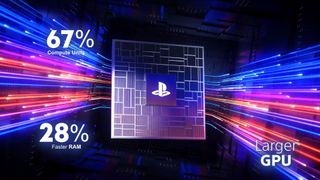The PS5 Pro and Steam Deck couldn’t be further apart. One is a home console requiring controllers, cables, and a TV. The other is a handheld Linux-powered PC. So why am I seeing more people than I’d expect compare these two since Sony’s PS5 Pro announcement?
There’s a certain shock factor to the PS5 Pro’s price tag. That’s a big part of it. The digital-only, mid-generation console is priced at $700. In other words, a console for the cost of a gaming PC. That’s not high-end PC money—who are we kidding, it’s half the price of an RTX 4090 alone—but genuine gaming PC cash nonetheless.
Pertinently, the PS5 Pro is the same price as not one, but two 256 GB Steam Deck LCDs, or $100 more expensive than a 1 TB Steam Deck OLED. I won’t belabour the point, but you could get a Steam Deck and a helluva lot of PC games for the price of a PS5 Pro.
So, should you buy a Steam Deck instead of a PS5 Pro? And is that even fair to compare these two devices anyways?
My guy reaction is, no, it’s not a fair comparison. For one, these are entirely different form factors, and I feel most would agree that comparing the Nintendo Switch and the Xbox Series X would be a fool’s errand. Same goes for the PS5 Pro and Steam Deck.
But, call me a fool, I’ll compare the two anyways. Just to give an idea of how ludicrous any direct specs comparison really is.
From what we know about the PS5 Pro, it appears to be a relatively powerful device for the money. It’s true that in console terms, the PS5 Pro is the most expensive yet. Yet in PC gaming terms, in some respects, it’s a bit of a bargain.
Sony has mostly focused on the GPU for its ‘Pro’ improvements here, with a vastly increased GPU component within the PS5 Pro’s AMD-designed APU. This new chip features 60 Compute Units (CUs), for a sum total of 3,840 cores, likely of RDNA 3 origin. That makes for a serious step up over the 36 RDNA 2 CUs found on the standard PlayStation 5 model.

The desktop graphics card equivalent would be the AMD Radeon RX 7800 XT, which also has 60 RDNA 3 CUs. That GPU was first launched just over a year ago for $499, though it’s a little cheaper today. It would be a big chunk of your PS5 Pro budget should you wish to try to build a comparative PC for the same money (you can’t without some serious bargain bin diving or second-hand snooping).
| Header Cell – Column 0 | PS5 Pro | PS5 |
|---|---|---|
| CPU | Zen 2 (unconfirmed) | Zen 2 |
| Cores/threads | 8/16 | 8/16 |
| GPU | RDNA 3 (unconfirmed) | RDNA 2 |
| Compute Units | 60 | 36 |
| Memory | 18 Gbps GDDR6 | 14 Gbps GDDR6 |
| MSRP (at launch) | $700 | $499 / $399 |
CUs are an important metric, as more of these means a bigger chip with more performance in games. But this isn’t entirely an apples-to-apples comparison. The RX 7800 XT has dedicated VRAM, thermal and power limits in excess of what Sony’s console will surely handle, and it has the benefit of flexibility to choose what you pair it with inside a PC. That will amount to higher performance from the PC part.
But not the Steam Deck.
The Steam Deck might be a pocket-sized PC, and also come with an AMD-designed APU, though it’s an entirely different beast to both console and gaming PC. An APU complete with a mere eight CUs of RDNA 2 graphics—or 86% smaller than the PS5 Pro—it’s made to meet different design goals. It’s a compact device with a low TDP to improve its battery life, which isn’t even a consideration for PC or console, and it balances thermal and power constraints with game performance to offer a portable experience that’s half-decent away from the outlet.
At least both devices are pretty evenly matched in the CPU department. Eight cores, 16 threads, Zen 2, bish, bash, bosh.
Clearly, there’s nothing much to compare here. So, what causes more people than I would have expected to jump to the Steam Deck as the viable alternative to the PS5 Pro? These two devices clearly couldn’t be much further apart.
It comes down to an argument for the holistic gaming experience.
The PS5 Pro offers an improved experience. You sit down in front of the TV to play some games at the end of a long day and you’ll find it delivers a higher quality, higher frame rate, experience than the standard PS5.

The Steam Deck offers a novel and new way for accessing PC games. Perhaps, for some, a new experience. That’s why so many feel so strongly about its value proposition: you don’t play the Steam Deck instead of your gaming PC, you play it when you don’t have access to your gaming PC. That means more time to play games and more opportunity to try new ones. You might find you stop caring so much about frame rate, even.
This isn’t an experience limited to the Steam Deck. Any handheld gaming PC, or handheld console, offers the same sort of flexibility. It’s why the Nintendo Switch is so immensely popular. I just think a lot of PC gamers’ eyes were opened to the modern portable gaming paradigm when they first got their hands on the Steam Deck. Even as a Switch owner, I found myself praising the Steam Deck not for its specs, but for the time it afforded me to play PC games when I wouldn’t have been able to previously.
It’s a strong case to be made for the Steam Deck, and combine that with the relatively weak argument for upgrading to a PS5 Pro, and the recommendations to ‘Just buy a Steam Deck’ make marginally more sense.
But I still think telling someone to go buy a Steam Deck instead of a PS5 Pro is pretty weak advice. They’re categorically not the same thing—they don’t even aim to appeal to the same audience.
For the record, I don’t think you should buy a PS5 Pro, either. Save your money for the next generation or pinch pennies long enough to buy a gaming PC. Oh, you forgot you were reading PC Gamer?
If you’ll afford me one little PC Gamer rant about consoles, I’ve never understood why consoles insist on degrading ease of use and adding complexity for customers and developers when simplicity and affordability are their strongest traits? Why make a new 3DS that hardly any developer will support? Or two Xbox consoles, except one is hamstrung by its memory? Or a massively improved mid-generation overhaul for a console generation that’s frequently cited for having few must-play games? It all feels unnecessary—a way to bump up sales while threatening the entire point of consoles to begin with.
At least the Switch (mostly) bumps the trend with only an OLED upgrade, and look how well that’s worked out for Nintendo. But if consoles are going to tune their appeal to be more about flexibility, options, and premium experiences—the PC already does it better.
